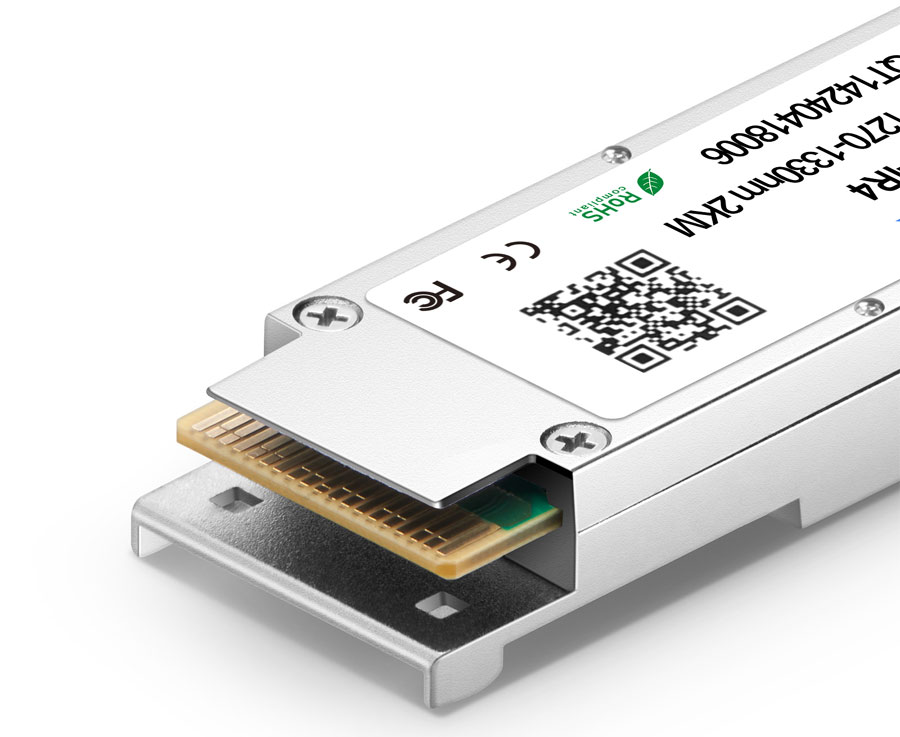
100G IR4: High-Speed AI & HPC Cluster Interconnect Solution
Deploying 100G IR4 for AI and HPC Cluster Interconnects
As AI workloads and high-performance computing (HPC) clusters become increasingly data-intensive, the demand for faster, more efficient interconnects has grown significantly. Enterprises and research institutions deploying AI training models or operating massive HPC environments need networking solutions that strike a balance between ultra-low latency and high bandwidth. The 100G IR4 optical transceiver offers a compelling answer to this challenge.
What Is 100G IR4
100G IR4 is a 100 Gigabit Ethernet optical transceiver that uses four lanes of 25 Gbps data over single-mode fiber (SMF) to achieve a total bandwidth of 100Gbps. It supports transmission distances of up to 2 kilometers and uses the CWDM (Coarse Wavelength Division Multiplexing) technology, operating over a duplex LC interface. The module complies with the IEEE 802.3ba standard and typically uses NRZ (Non-Return-to-Zero) modulation.
This makes it ideal for mid-range data center connections and a strong candidate for AI and HPC interconnects that require predictable performance, reliability, and scalability.

Meeting the Demands of AI and HPC
In AI training environments, massive datasets are constantly exchanged between GPU servers, storage arrays, and orchestration nodes. In HPC, scientific simulations and modeling tasks produce intense east-west traffic across computing nodes. Traditional 10G or even 40G connections fall short in terms of both bandwidth and latency, resulting in performance bottlenecks.
100G IR4 helps overcome these challenges in the following ways:
High Bandwidth per Port
With 100Gbps per link, 100G transceivers can eliminate the need for port aggregation and reduce overall switch port usage. This is crucial when scaling up AI training platforms where bandwidth-hungry accelerators like GPUs and TPUs are deployed in large numbers.
Low Latency Interconnects
In distributed AI and HPC workloads, latency directly affects performance. IR4 modules, operating over direct optical paths and minimal conversion overhead, provide lower latency than many legacy electrical or aggregated optical solutions.
2km Reach Is a Perfect Fit
AI and HPC clusters often span multiple rows in a data hall or even across nearby buildings. The 2km transmission range of 100G IR4 is well-suited for such mid-distance deployments, avoiding the overkill (and higher cost) of longer-range solutions like 100G ER4.

Practical Deployment Advantages
Ease of Integration
100G IR4 transceivers use duplex LC connectors and are compatible with standard SMF cabling, making them easy to deploy in existing fiber infrastructures without needing specialized hardware.
Energy Efficiency
Compared to coherent optical modules or electrical alternatives that achieve similar bandwidth, 100G IR4 modules typically consume less power (<4W), helping to control energy usage in dense, high-compute environments.
Scalability
As demand grows, deploying leaf-spine network architectures using 100G IR4 modules ensures scalability without incurring massive upfront investment.

Conclusion
For AI and HPC cluster operators seeking an efficient, cost-effective way to upgrade their interconnect infrastructure, 100G IR4 strikes the right balance between bandwidth, latency, and deployment flexibility. It’s fast enough for today’s most demanding workloads and scalable enough to support tomorrow’s innovations—whether that’s generative AI training, genome modeling, or weather simulations.











